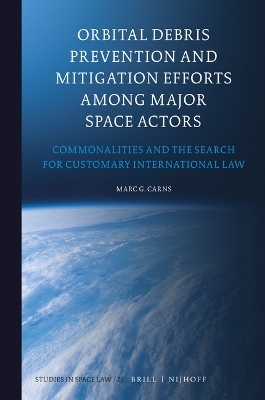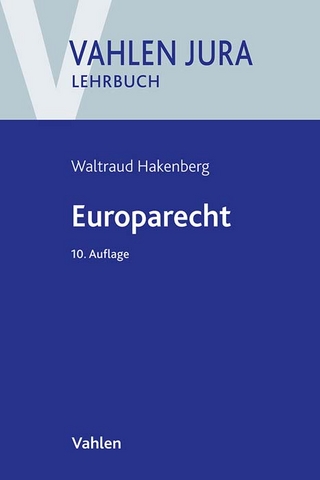
Orbital Debris Prevention and Mitigation Efforts among Major Space Actors
Martinus Nijhoff (Verlag)
978-90-04-53583-1 (ISBN)
Lieutenant Colonel (Dr.) Marc G. Carns, LL.M. (2016), J.S.D. (2022) University of Nebraska, is a career United States Air Force Military Officer and Air Force Judge Advocate. Lt Col. Carns specializes in advising on legal issues affecting national security and defense initiatives in Air, Space, and Cyberspace. He also serves as an adjunct professor at various universities.
Preface
List of Figures
Abbreviations
Introduction Access for All
1 The Debris Problem
1 Introduction
1.1 Early Recognition of the Risk of Space Debris
2 Space Debris Defined
3 Space Debris Creation
4 Identifying the Degree of Space Debris Accumulation—What Is Space ssa?
4.1 Who Is Responsible for ssa Management?
4.2 Other ssa Programs
4.3 How Are Space Objects (and Debris) Identified and Tracked?
4.4 How Does ssa Work
5 Conclusion
2 International Law and the Formal Space Treaties
1 Introduction
2 Public International Law
2.1 Development of Public International Law Related to Space
3 International Space Treaties
3.1 Treaty on Principles Governing the Activities of States in the Exploration and Use of Outer Space, including the Moon and Other Celestial Bodies
3.1.1 Outer Space Treaty, Article i
3.1.2 Outer Space Treaty, Article ii
3.1.3 Outer Space Treaty, Article iii
3.1.4 Outer Space Treaty, Article ix
3.1.5 Outer Space Treaty, Article xi
3.2 The Remaining ‘Big 4’ International Space Treaties
4 Jurisdiction of Space Objects
5 Registration of Space Objects
6 Conclusion
3 Development of Customary International Law—Space Law and Debris Mitigation
1 Introduction
2 Basic Requirements of Customary International Law
2.1 Time Requirement of Customary International Law
2.1.1 How Important Is the Time Element of Customary International Law in Modern Times
2.1.2 Continuous Claim and Response
2.1.3 Harry S. Truman and the Continental Shelf—Testing the Time Requirement
2.1.4 Legitimacy of Instant Customary International Law in the Courts
3 Instant Customary International Law in Space Law
3.1 Post-Truman—Sputnik as the Next Use Case
4 International Efforts in Space Debris Mitigation—on the Cusp of Customary International Law
4.1 The United Nations Space Debris Mitigation Guidelines of the Committee on the Peaceful Uses of Outer Space
4.1.1 Leading to the Mitigation Guidelines—Initial Assessments of Nation-State Efforts
4.1.2 From Analysis to Understanding—the Development of the Debris Mitigation Guidelines
4.1.3 From Understanding to Action—Drafting the Debris Mitigation Guidelines
4.1.4 Reviewing the Impact: Debris Mitigation Guidelines
5 International Telecommunications Union
6 Conclusion
4 The United States—Space Debris Mitigation, Prevention, and Policy
1 Introduction—US Space Debris Policy
1.1 Development of National-Level US Space Debris Policy
1.2 Orbital Debris Mitigation Standard Practices and spd-3
1.3 2020 US National Space Policy
1.3.1 The Six Principles of President Trump’s National Space Policy
1.3.2 The Eight Goals of President Trump’s National Space Policy
1.3.3 President Trump’s National Space Policy and Orbital Debris
1.4 Impact of odmsp Changes and US Policy
2 Federal Aviation Administration
2.1 Roles of the Federal Aviation Administration Office of Commercial Space Transport
2.2 Federal Aviation Administration Office of Commercial Space Transport Licensing
2.3 Requirements for Initial Licensing Considerations
2.4 Assessing Launch Risk
2.5 Launch Application and License
2.6 Licensing and Orbital Debris
2.7 Debris Avoidance from Collision
2.8 End of Operations
3 Federal Communications Commission
3.1 Authority to License
3.2 Licensing Requirements
3.3 Title 47 c.f.r. (Telecommunication) and New Orbital Debris Rules
3.3.1 Title 47 c.f.r. Part 5—Experimental Radio Service, 47 c.f.r. §5.64(b)-Special Provisions for Satellite Systems
3.3.2 Title 47 c.f.r. Part 25—Satellite Communications
3.3.3 Title 47 c.f.r. Part 97—Space Station
3.4 Evolution of fcc Efforts toward Addressing Orbital Debris Mitigation Efforts
3.5 fcc and the Way Ahead
4 The US National Space Council
5 Conclusion
5 China
1 Introduction to the Chinese Space Program
2 Background of the Development of the Chinese Space Program
3 The Modern Chinese Space Program
4 The Legislative Governance Elements of the Chinese Space Program
4.1 China’s Civil Space Program Management
5 Chinese Regulatory Efforts toward Sustainability and Orbital Debris
5.1 China and International Space Agreements
5.2 Chinese Regulations Based on International Commitments
5.3 Domestic Departmental-Level Regulations
5.3.1 China’s Existing Space Regulations—2001 Measures for the Administration of Registration of Objects Launched into Outer Space
5.3.2 China’s Existing Space Regulations—the Interim Measures on the Administration of Licensing the Project of Launching Civil Space
5.4 The 2010 Interim Instrument on Space Debris Mitigation and Management Instrument
6 China’s Space Policy—the Chinese White Papers
6.1 The 2000 China Space White Paper
6.2 The 2006 China Space White Paper
6.3 The 2011 China Space White Paper
6.4 The 2016 China White Paper
6.5 The 2021 China White Paper
6.6 Words versus Actions—Are the Chinese Actually Committed to the Space Sustainability Discussed in Their White Papers?
7 Conclusion—the Future of China’s Space Program
6 Russia
1 Introduction
2 Russian Interpretation of International Law Influencing Russian Space Law
2.1 Overview of Russian Approach to International Law
2.2 Modern Russian Approach to International Law
3 Russia’s Domestic Implementation of Obligations under International Space Law
3.1 Russian Domestic Space Debris Regulatory Scheme
3.1.1 Russian Domestic Regulatory Scheme—Decree No. 5663–1, about Space Activities
3.2 Licensing in Russia
3.3 Principal Space Debris Regulation—gost p 52925–2018
3.3.1 Debris Reduction through Design
3.3.2 Debris Reduction during Operations
3.3.3 Debris Reduction during Post-mission Disposal
4 Conclusion
7 European Space Agency
1 Introduction
2 esa Today
2.1 esa Membership
2.2 esa Programs and Participant Requirements
3 esa and International Legal Standing and Authority
3.1 esa and International Agreements
3.2 Creation of International Legal Norms—esa Customary International Law
3.3 esa and Space Debris Legal Norms
4 Specific Efforts at Forming Legal Norms for Space Debris Mitigation and Prevention
4.1 esa Space Debris Mitigation Handbook
4.2 European Code of Conduct for Space Debris Mitigation
4.3 European International Code of Conduct for Outer Space Activities
5 International Organization for Standardization Debris Mitigation Guidelines
5.1 iso and esa Adoption of Debris Standards—iso 24113:2010 through iso 24113:2019
5.1.1 iso 24113:2019—Space Systems-Space Debris Mitigation Requirements
5.2 Progeny of iso 24113:2019—Debris Mitigation for Spacecraft and Launch Vehicles
5.2.1 Space Debris Mitigation Requirements for Spacecraft—iso 16164:2015, iso 26872:2019, iso 23339:2012, iso 16127:2014
5.2.2 Space Debris Mitigation Requirements for Launch Vehicles
6 Beyond esa iso Standards
6.1 European Union Space Strategy for Europe
7 Conclusion
8 Does Existing Space Debris Guidance Establish Customary International Law?
1 Introduction
2 Beyond Legacy iadc and UN copuos—Recent Voluntary Space Debris Mitigation Guidelines
2.1 Committee on the Peaceful Uses of Outer Space Guidelines for the Long-Term Sustainability of Outer Space Activities
2.1.1 UN copuos lts Guidelines—Policy and Regulatory Framework
2.1.2 UN copuos lts Guidelines—Safety of Space Operations
2.1.3 UN copuos lts Guidelines—International Cooperation and Capacity Building and Awareness
2.1.4 UN copuos lts Guidelines—Scientific and Technical Research and Development
2.1.5 UN copuos lts Guidelines—the Way Ahead
2.2 Background—Space Safety Coalition Best Practices for the Sustainability of Space Operations Guidelines
2.2.1 ssc Sustainability Practices
3 Can Customary International Law Be Found as a Result of Nation-State Implementation of Orbital Debris Prevention and Mitigation Efforts?
3.1 The Seven Mitigation Themes
3.1.1 Theme 1—Debris Mitigation Is to Be Considered during All Stages of a Space Project
3.1.2 Theme 2—Release of Space Debris during Normal Operations Is to be Limited
3.1.3 Theme 3—Efforts Should Be Expended to Avoid Collisions in Orbit
3.1.4 Theme 4—Risk of Breakups during Operational Phases is to be Minimized
3.1.5 Theme 5—the Potential for Post-mission Breakups Resulting from Stored Energy Should Be Minimized by Passivation
3.1.6 Theme 6—If Not Destroyed by Atmospheric Methods, Post-mission Disposal of Space Objects Away from leo and geo Is to Be Arranged
3.1.7 Theme 7—Intentional Destruction and Other Harmful Activities Are to Be Avoided
4 Do Any Similarities in the Way Nations Implement the Standards Represented within the Themes Meet the Standards of Customary International Law?
4.1 The 25 Year ‘Rule’
5 Conclusion
9 Where Do We Go from Here?
1 Introduction
2 Is Soft Law Appropriate to Address the Space Debris Issue at All?
2.1 Though Soft Law Is Not a Likely Solution, Treaty Law Is Equally Elusive to Solve the Problem
3 Is New Governance the Answer? Evolving Space Governance—Past, Present and Future
3.1 Space Governance—Where We Were
3.2 Space Governance—Where We Are
3.3 Space Governance—Do We Need a Different Governance Model (Where Are We Going)?
4 One Key Option to Solve the Debris Problem—Active Debris Removal and Legal Challenges
4.1 Background on Modern adr Efforts
4.2 Current Major adr Efforts
4.2.1 Lasers
4.2.2 Solar Sails
4.2.3 Harpoons
4.2.4 Grappling Arms/Claws
4.2.5 System Capture and Containment
4.3 Legal Challenges to Implementation of adr
4.4 Recommendations to Address Debris Removal Legal Challenges
4.4.1 Instant Customary International Law in Practice
5 A Need to “Go It Alone” to Establish Customary International Law?
5.1 “Going It Alone”—Principles for Successful Independent adr Activity
6 Conclusion
References
Index
| Erscheinungsdatum | 10.07.2023 |
|---|---|
| Reihe/Serie | Studies in Space Law ; 20 |
| Sprache | englisch |
| Maße | 155 x 235 mm |
| Gewicht | 828 g |
| Themenwelt | Recht / Steuern ► EU / Internationales Recht |
| ISBN-10 | 90-04-53583-7 / 9004535837 |
| ISBN-13 | 978-90-04-53583-1 / 9789004535831 |
| Zustand | Neuware |
| Haben Sie eine Frage zum Produkt? |
aus dem Bereich


